Of the Man’s – The Man Lun Fung Ancestral Hall
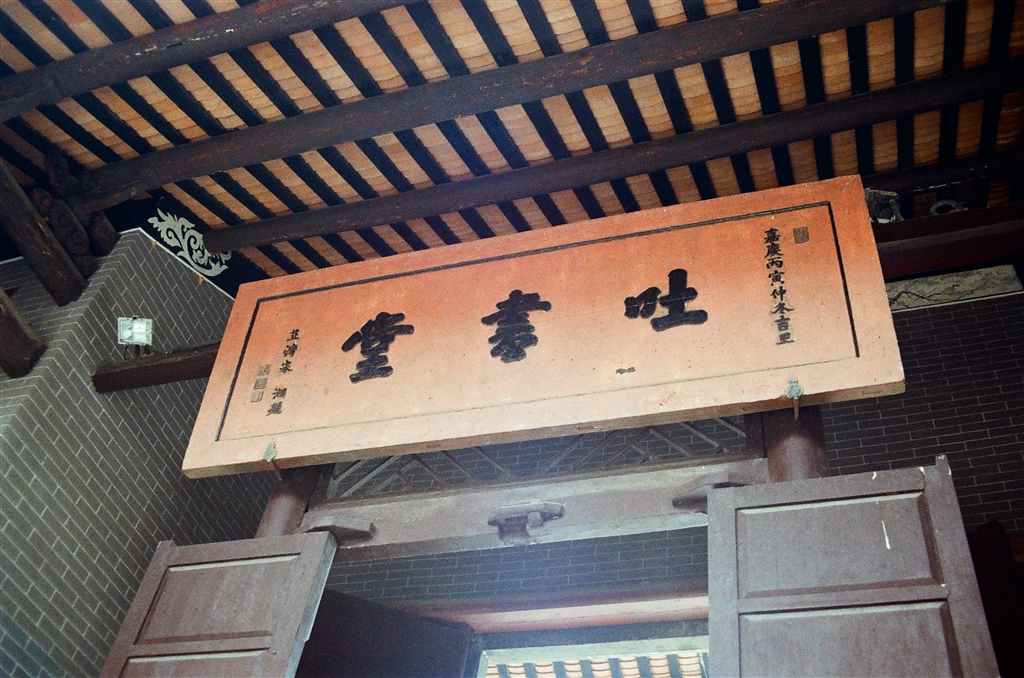
I have previously written on the Tai Fu Tai and Tung Shan Temple. Both are landmarks that stand testament to the Man’s history in San Tin, Yuen Long. Since there are more such heritage sites, I decided to visit San Tin again to seek out the Man Lun Fung Ancestral Hall, the Man Sun Ye Ancestral Hall and the Man Ancestral Hall (also known as Dun Yu Tong).
The Man’s of San Tin
I have briefly told the story of the Man clan’s origins in my entry on the Tung Shan Temple. To trace back to a time even earlier than the direct lineage ancestor Man Tin-shui, I learned more when I did research for this entry on the Man Lun Fung Ancestral Hall.
An early ancestor of the Man’s was a Han Dynasty general that stationed in Chengdu, Sichuan. During the Five Dynasties and Ten Kingdoms period, the Man’s moved to Jiangxi. At the end of the Southern Song Dynasty, when Mongolian forces captured Wen Tianxiang, his cousin on the paternal line, Man Tin-shui fled to Baoan, Guangzhou. What followed was the further moving-south of Man Sai-kor, who was the seventh generation ancestor after Man Tin-shui, to San Tin. Man Sai-kor founded the Man villages here in Hong Kong.
The Man Lun Fung Ancestral Hall commemorates Man Fat-po (also named Man Lun-Fung), who was of the 8th generation of the Man ancestors. He was the second son of Man Sai-kor.
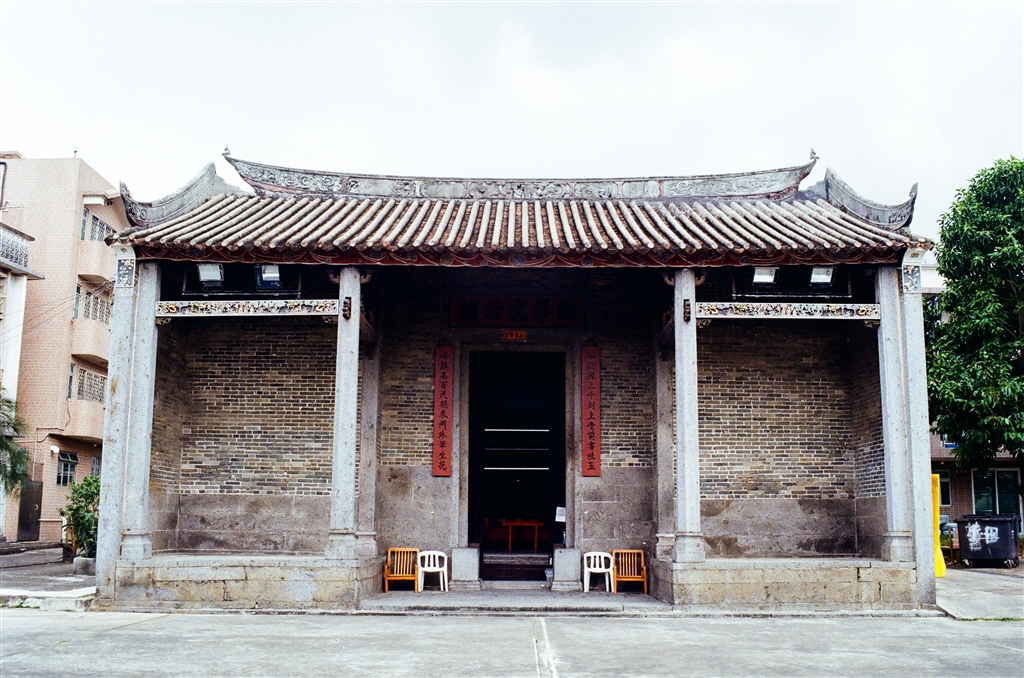
The Man’s efforts to settle down in this area of Hong Kong were successful, and they changed the face of this land. When they first came to this area of Yuen Long, it was a swamp. They used a simple method to drain the land, and turned it into arable fields. As a result, people named this place San Tin, meaning “new fields,” to note the Man’s successful turnaround of their livelihood in this new home.
The Man Lun Fung Ancestral Hall
There are at least five ancestral halls of the Man’s in San Tin. Of the three ancestral halls I saw in this visit, I think the Man Lun Fung Ancestral Hall has made the most favorable impression.
The Man’s built it during the mid to late 17th century. During its long history, the Man Lun Fung Ancestral Hall has served many purposes, as community, cultural, ceremonial and educational venue for the Man clan. Some villagers still remember it as a school. Today, the Man’s celebrate traditional festivities mostly at this ancestral hall. For example, the ancestral worship at Chung Yeung Festival is one of the most important events of the year. For Chinese New Year, there is a lantern-lighting celebration here. It has also been the meeting place for village elders.
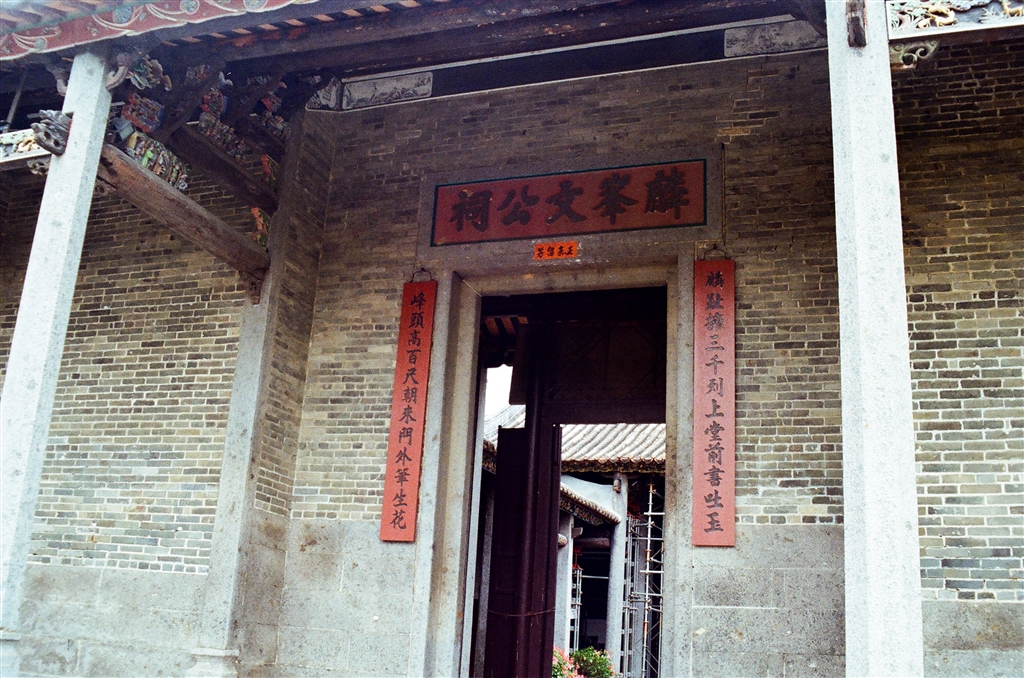
The Man Lun Fung Ancestral Hall became a monument in 1983. In 1987, the Antiquities and Monuments Office restored it with donations from the Jockey Club. In 1995, it underwent another restoration with government funds.
Features of the Man Lun Fung Ancestral Hall
Unlike the Tai Fu Tai, the Qing Dynasty mansion home for Man Chung-luen, that features elements of mixed western and traditional styles, the Man Lun Fung Ancestral Hall is purely traditional in all its architecture.
The layout is one of three halls on its main axis with two enclosed courtyards. Viewed from the interior of the first main hall, a plaque with the words “To Shu Tong” hangs on the high beam at the hallway. “To Shu Tong,” standing alone, means “the hall of speaking with scholarship.” Indeed, this plaque itself is a cultural relic. In the 11th year of the Jiaqing Reign (1806), Song Xiang, who was admired as Lingnan’s most gifted scholar, wrote these very three words for the Man Lun Fung Ancestral Hall.
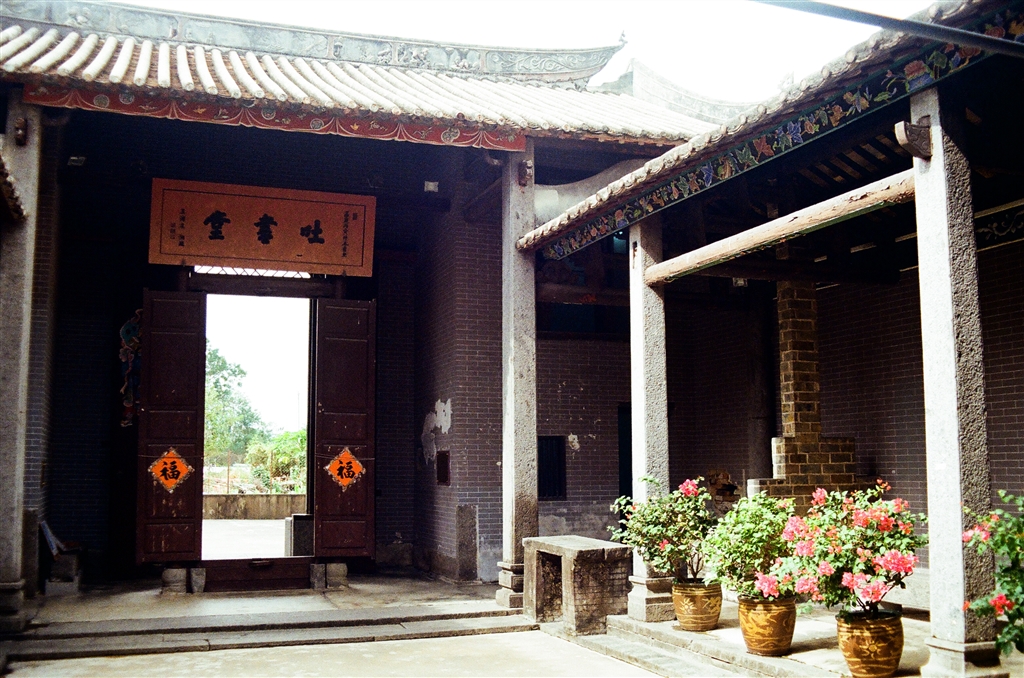
Lun Fung is the name of the ancestor to which this ancestral hall is dedicated. The word “Lun” means the mythical creature kirin. Culturally, it also means sons. The phrase “Kirin To Yuk Shu” refers to the imagery of a kirin spewing a jade book. It serves as the omen for the birth of a son destined to make scholarly accomplishments. Legend has it that a kirin spewed out a jade book when Confucius was born.
The couplets lining the sides of the front entrance also refer to learnedness. This is very intriguing to me. Most of the ancestral halls feature couplets and plaques themed in auspicious phrases. References to erudition are rare. At that moment, I felt that this blue-brick building, with its unusually high ceiling and beautiful, aged carvings on the beams, to carry a sense of the lyrical and the poetic.
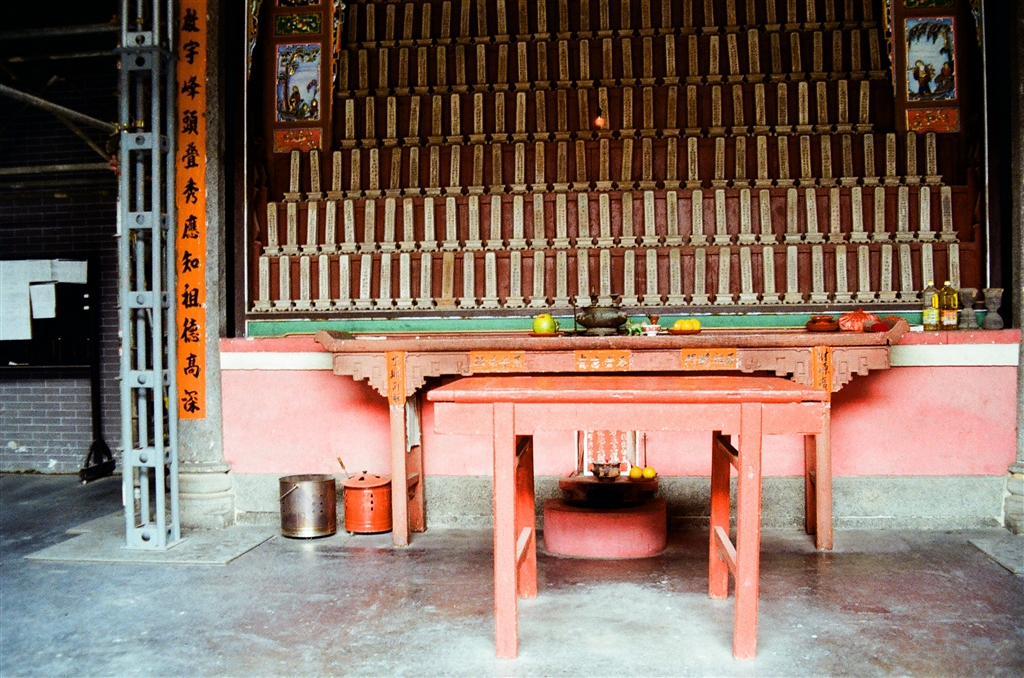
Photo: The Man ancestors’ soul tablets are enshrined in the main hall of the Man Lun Fung Ancestral Hall.
Perhaps I like the Lun Fung Ancestral Hall even more so than the Tung Shan Temple. As it has been more than twenty years since its last restoration, the Lun Fung Ancestral Hall is showing signs of age. The recently-restored Tung Shan Temple has brilliant colors that convey a sense of bold authority. In contrast, the Man Lun Fung Ancestral Hall commands respect and solemnity due to its height and an aged elegance. It was humble but no less respected.
When I visited at the end of 2021, I saw some workers there setting up some kind of structural repair. I think they were adding reinforcements to the structure.
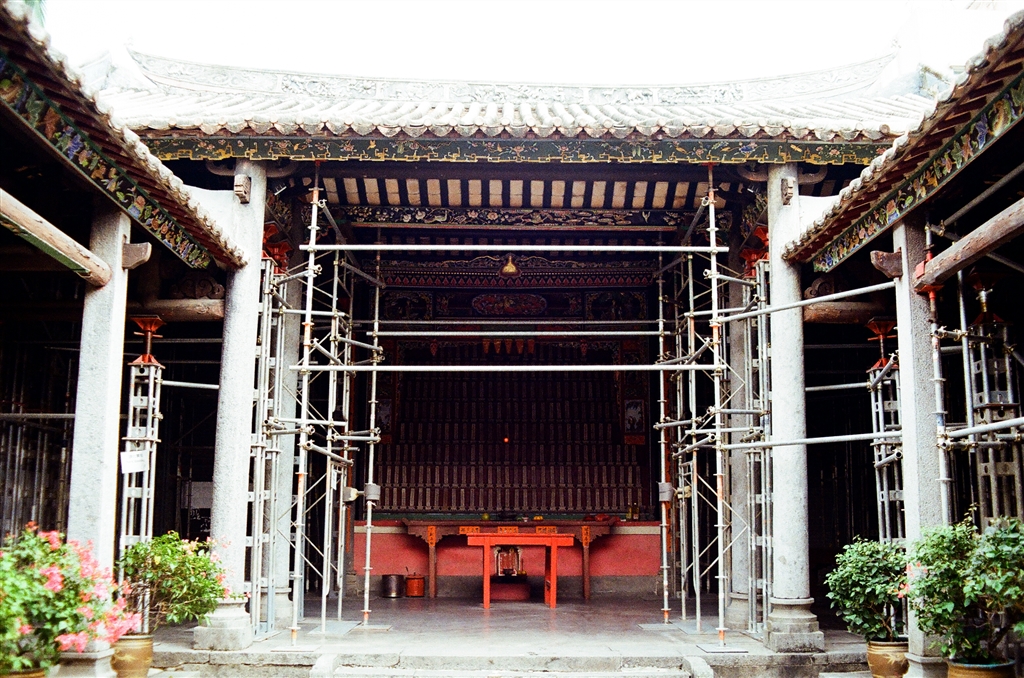
The Man Sun Ye Ancestral Hall
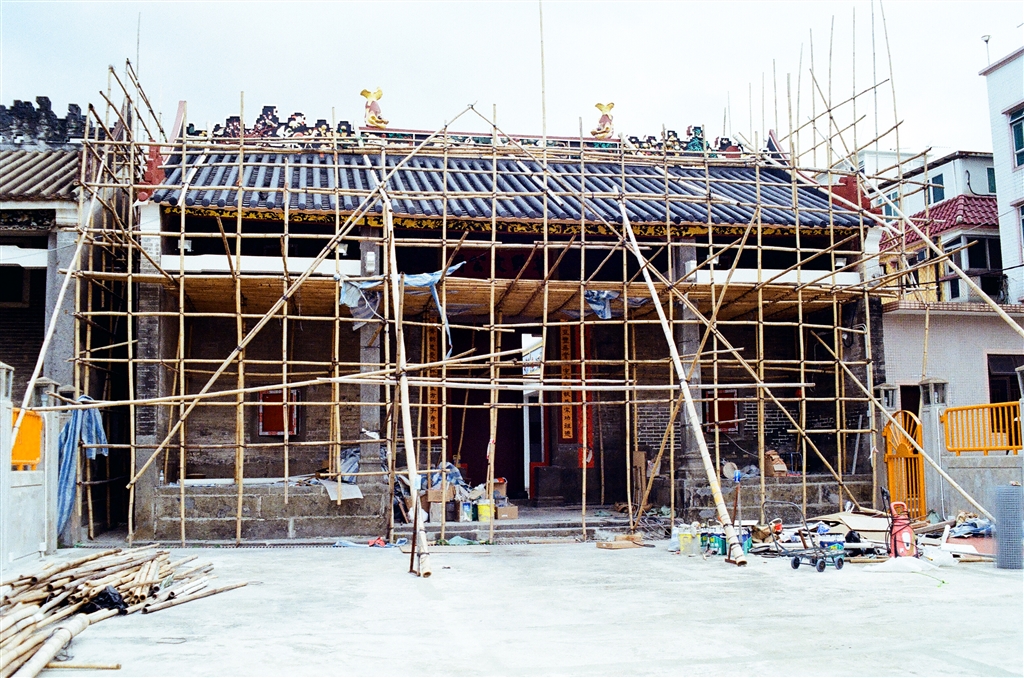
There are so many ancestral halls for the Man’s in San Tin because each side lineage within the clan commemorates its ancestors with an ancestral hall. The Man Sun Ye Ancestral Hall belongs to a branch lineage of the Man’s. As such, it remains closed to visitors.
The Man Sun Ye Ancestral Hall was built in the mid-18th century. An interesting fact is that the Man Sun Ye Ancestral Hall is built to the same form as the Man Ancestral Hall (see below) next to it. For the Man Ancestral Hall commemorates all lines of Man Ancestors as the original ancestral hall.
When I visited, I saw significant revamping work at the site. It would not have made any difference though, since the site is not open to public visit. It is a Grade 2 Historic Building. Given the current state of restoration as shown in this photograph, I believe the structure will show a kind of brightness similar to the Tung Shan Temple when the process finishes.
The Man Ancestral Hall (Also Known As Dun Yu Tong)
The Man Ancestral Hall is the original ancestral hall of the Man’s in Fan Tin Tsuen Village. It is believed that the founding father of the Man clan in San Tin, Man Sai-kor, built the Man Ancestral Hall. The year of construction is believed to be 1444, during the Ming Dynasty. There is also no public access to this ancestral hall.
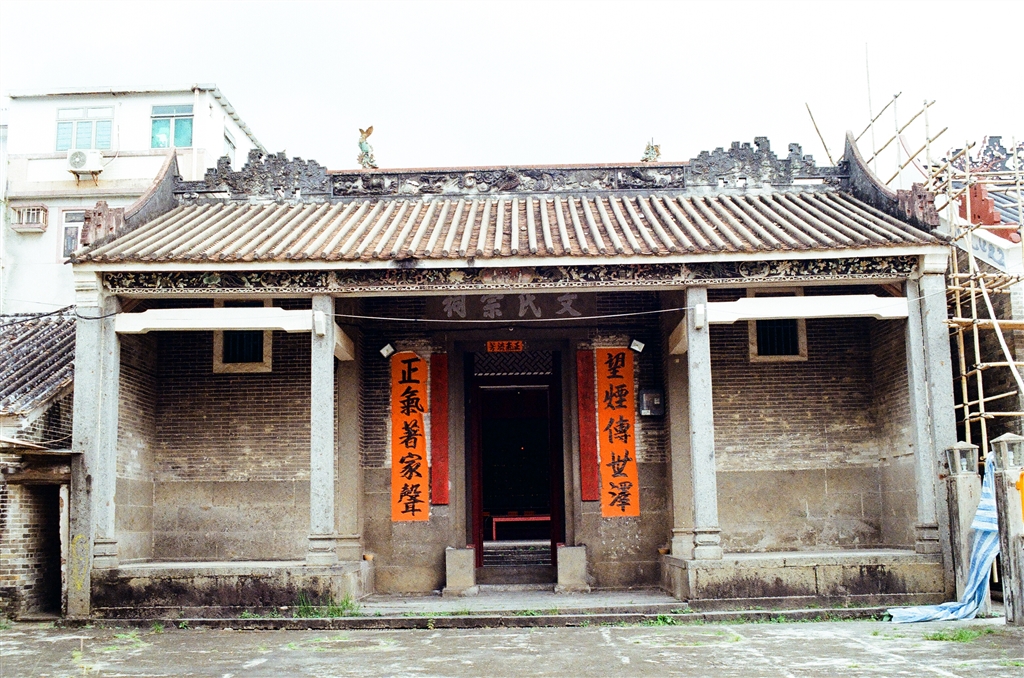
How to Get There
Take Bus 76K either from Sheung Shui or Yuen Long and get off at the San Tin stop. Pass the restaurants and you will be at the road that leads you to the Tai Fu Tai, with signs pointing you also to the Man Lun Fung Ancestral Hall. This path will lead you to Fan Tin Tsuen Village within the San Tin area. The three ancestral halls stand within the vicinity of each other.
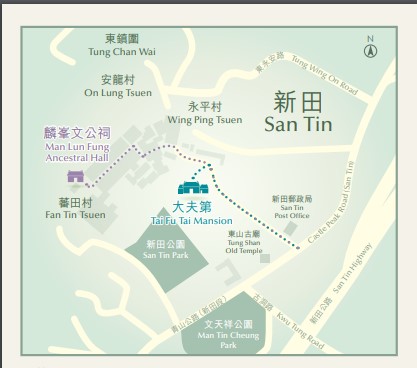
The map is from the Aniquities and Monuments Office, see first citation under Sources.
Further Reading
This is part of the series on the Man clan’s history in San Tin, Yuen Long. See also the entries on Tai Fu Tai and Tung Shan Temple. Consider doing all these sites in one trip. It is doable within a half day.
Sources
Antiquities and Monuments Office, Tai Fu Tai, Man Lun Fung Ancestral Hall, 2021.
Ng Ka Fai, Leung Yan Cheong, A Study on the Man’s of San Tin, Historical Value and Cultural Heritage, A Year-end Thesis for the course Hong Kong Historical Artifacts and Monuments, Department of History at the Chinese University of Hong Kong, April 22, 2006.
The Wikipedia on the Man’s of San Tin (Chin).
The Wikipedia on Song Xiang (Chin).
The Wikipedia on the Man Sun Ye Ancestral Hall (Chin).
The Wikipedia on the Man Ancestral Hall (Dun Yu Tong) (Chin).
Kirin Spews a Jade Book (Chin), baike.baidu.hk.
Yi Tung, In Search of Cultural Monuments in the New Territories (2008), at 79-82.
